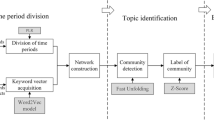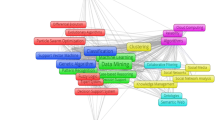Abstract
Understanding the complex patterns in research funding plays a fundamental role in comprehensively revealing funding preferences and informing ideas for future strategic innovation. This is especially true when the funding policies need to be constantly shifted to accommodate highly complex and ever-changing demands for technological, economic, and social development. To this end, we investigate the associations between funding agencies and the topics they fund in an attempt to understand funding patterns at both an organizational level and a topic level. In this paper, the links between heterogeneous nodes, organizations and topics, are mapped to a two-mode organization–topic network. The collaborative interactions formed by funding organizations and the semantic networks constituted by word embedding-enhanced topics are revealed and analyzed simultaneously. The methodology is demonstrated through a case study on big data research involving 9882 articles from the Web of Science over the period 2010 to 2019. The result shows a comprehensive picture of the topics that governments, academic institutions, and industrial funding organizations prefer to fund, which provide potential decision support for agencies and organizations who are exploring funding patterns, estimating funding trends, and updating their funding strategies.









Similar content being viewed by others
Notes
The search strategy for funding organization: FO = (a* or b* or c* or d* or e* or f* or g* or h* or i* or j* or k* or l* or m* or n* or o* or p* or q* or r* or s* or t* or u* or v* or w* or x* or y* or z* or 1* or 2* or 3* or 4* or 5* or 6* or 7* or 8* or 9* or 0*).
Complete and detailed funding proportion for all topics are provided in “Appendix”.
References
Aagaard, K., Mongeon, P., Ramos-Vielba, I., & Thomas, D. A. (2021). Getting to the bottom of research funding: Acknowledging the complexity of funding dynamics. PLoS ONE. https://doi.org/10.1371/journal.pone.0251488
Acharya, A., Singh, S. K., Pereira, V., & Singh, P. (2018). Big data, knowledge co-creation and decision making in fashion industry. International Journal of Information Management, 42, 90–101.
Blei, D. M., Ng, A. Y., & Jordan, M. I. (2003). Latent Dirichlet allocation. Journal of Machine Learning Research, 3, 993–1022.
Brennecke, J., & Rank, O. (2017). The firm’s knowledge network and the transfer of advice among corporate inventors—A multilevel network study. Research Policy, 46, 768–783.
Chang, S.-H. (2017). The technology networks and development trends of university–industry collaborative patents. Technological Forecasting and Social Change, 118, 107–113.
Chen, Y. L., Dong, Y. T., Zeng, Y., Yang, X. Y., Shen, J. T., Zheng, L., Jiang, J. W., Pu, L. M., & Bao, Q. L. (2020). Mapping of diseases from clinical medicine research—A visualization study. Scientometrics, 125, 171–185.
Chen, H., Jin, Q., Wang, X., & Xiong, F. (2022). Profiling academic–industrial collaborations in bibliometric-enhanced topic networks: A case study on digitalization research. Technological Forecasting and Social Change, 175, 121402.
Chen, H., Wang, X., Pan, S., & Xiong, F. (2021). Identify topic relations in scientific literature using topic modeling. IEEE Transactions on Engineering Management, 68, 1232–1244.
Chen, H. S., Zhang, G. Q., Zhu, D. H., & Lu, J. (2017). Topic-based technological forecasting based on patent data: A case study of Australian patents from 2000 to 2014. Technological Forecasting and Social Change, 119, 39–52.
Cheng, Y., Chen, K., Sun, H. M., Zhang, Y. P., & Tao, F. (2018). Data and knowledge mining with big data towards smart production. Journal of Industrial Information Integration, 9, 1–13.
Colatat, P. (2015). An organizational perspective to funding science: Collaborator novelty at DARPA. Research Policy, 44, 874–887.
De Battisti, F., Ferrara, A., & Salini, S. (2015). A decade of research in statistics: A topic model approach. Scientometrics, 103, 413–433.
Gao, J. P., Su, C., Wang, H. Y., Zhai, L. H., & Pan, Y. T. (2019). Research fund evaluation based on academic publication output analysis: The case of Chinese research fund evaluation. Scientometrics, 119, 959–972.
Greiner-Petter, A., Youssef, A., Ruas, T., Miller, B. R., Schubotz, M., Aizawa, A., & Gipp, B. (2020). Math-word embedding in math search and semantic extraction. Scientometrics, 125, 3017–3046.
Grimpe, C. (2012). Extramural research grants and scientists’ funding strategies: Beggars cannot be choosers? Research Policy, 41, 1448–1460.
Guan, J., Yan, Y., & Zhang, J. J. (2017). The impact of collaboration and knowledge networks on citations. Journal of Informetrics, 11, 407–422.
Guerzoni, M., Taylor Aldridge, T., Audretsch, D. B., & Desai, S. (2014). A new industry creation and originality: Insight from the funding sources of university patents. Research Policy, 43, 1697–1706.
Heinrich, G. (2005). Parameter estimation for text analysis. Technical Report.
Hellsten, I., & Leydesdorff, L. (2020). Automated analysis of actor–topic networks on Twitter: New approaches to the analysis of socio-semantic networks. Journal of the Association for Information Science and Technology, 71, 3–15.
Hu, K., Luo, Q., Qi, K. L., Yang, S. L., Mao, J., Fu, X. K., Zheng, J., Wu, H. Y., Guo, Y., & Zhu, Q. B. (2019). Understanding the topic evolution of scientific literatures like an evolving city: Using Google Word2Vec model and spatial autocorrelation analysis. Information Processing and Management, 56, 1185–1203.
Hu, Y.-H., Tai, C.-T., Liu, K. E., & Cai, C.-F. (2020). Identification of highly-cited papers using topic-model-based and bibliometric features: The consideration of keyword popularity. Journal of Informetrics, 14, 101004.
Huang, M. H., & Huang, M. J. (2018). An analysis of global research funding from subject field and funding agencies perspectives in the G9 countries. Scientometrics, 115, 833–847.
Huang, A. H., Lehavy, R., Zang, A. Y., & Zheng, R. (2018). Analyst information discovery and interpretation roles: A topic modeling approach. Management Science, 64, 2833–2855.
Huang, Y., Zhang, Y., Youtie, J., Porter, A. L., & Wang, X. (2016). How does national scientific funding support emerging interdisciplinary research: A comparison study of big data research in the US and China. PLoS ONE. https://doi.org/10.1371/journal.pone.0154509
Lamba, M., & Madhusudhan, M. (2019). Mapping of topics in DESIDOC Journal of Library and Information Technology, India: A study. Scientometrics, 120, 477–505.
Le, Q., & Mikolov, T. (2014). Distributed representations of sentences and documents. In Proceedings of the 31st international conference on machine learning (ICML-14), 2014 (pp. 1188–1196).
Lee, Y.-Y., Ke, H., Yen, T.-Y., Huang, H.-H., & Chen, H.-H. (2020). Combining and learning word embedding with WordNet for semantic relatedness and similarity measurement. Journal of the Association for Information Science and Technology, 71, 657–670.
Levy, O., Goldberg, Y., & Dagan, I. (2015). Improving distributional similarity with lessons learned from word embeddings. Transactions of the Association for Computational Linguistics, 3, 211–225.
Leydesdorff, L. (2003). The mutual information of university–industry–government relations: An indicator of the Triple Helix dynamics. Scientometrics, 58, 445–467.
Li, J., Xie, Y., Wu, D., & Chen, Y. (2017). Underestimating or overestimating the distribution inequality of research funding? The influence of funding sources and subdivision. Scientometrics, 112, 55–74.
Liu, W. (2020). Accuracy of funding information in Scopus: A comparative case study. Scientometrics, 124, 803–811.
Liu, Q., Srinivasan, A., Hu, J. K., & Wang, G. J. (2017). Preface: Security and privacy in big data clouds. Future Generation Computer Systems: The International Journal of Escience, 72, 206–207.
Liu, W., Tang, L., & Hu, G. (2020). Funding information in Web of Science: An updated overview. Scientometrics, 122, 1509–1524.
Ma, T. C., Li, R. N., Ou, G. Y., & Yue, M. L. (2018). Topic based research competitiveness evaluation. Scientometrics, 117, 789–803.
Mejia, C., & Kajikawa, Y. (2018). Using acknowledgement data to characterize funding organizations by the types of research sponsored: The case of robotics research. Scientometrics, 114, 883–904.
Mikolov, T., Chen, K., Corrado, G. S., & Dean, J. (2013a). Efficient estimation of word representations in vector space. In Proceedings of workshop at ICLR, 2013.
Mikolov, T., Sutskever, I., Chen, K., Corrado, G. S., & Dean, J. (2013b). Distributed representations of words and phrases and their compositionality. In Advances in neural information processing systems (pp. 3111–3119).
Moody, C. E. (2016). Mixing Dirichlet topic models and word embeddings to make lda2vec. arXiv: Computation and Language.
Munari, F., & Toschi, L. (2021). The impact of public funding on science valorisation: An analysis of the ERC Proof-of-Concept Programme. Research Policy, 50, 104211.
National Academies of Sciences, Engineering and Medicine. (2020). The endless frontier: The next 75 years in science. The National Academies Press.
Naumanen, M., Uusitalo, T., Huttunen-Saarivirta, E., & Van der Have, R. (2019). Development strategies for heavy duty electric battery vehicles: Comparison between China, EU, Japan and USA. Resources, Conservation and Recycling, 151, 104413.
Nooy, W. D., Mrvar, A., & Batagelj, V. (2011). Exploratory social network analysis with Pajek. Cambridge University Press.
Okeke, D. C., & Ukonze, I. (2019). Conceptualizing urban space (environment) for the delivery of sustainable urban development in Africa: Evidence from Enugu City in Nigeria. Land Use Policy, 87, 104074.
Phelps, C., Heidl, R., & Wadhwa, A. (2012). Knowledge, networks, and knowledge networks. Journal of Management, 38, 1115–1166.
Qadir, J., Sainz-de-Abajo, B., Khan, A., Garcia-Zapirain, B., de la Torre-Diez, I., & Mahmood, H. (2020). Towards mobile edge computing: Taxonomy, challenges, applications and future realms. IEEE Access, 8, 189129–189162.
Song, B., & Suh, Y. (2019). Identifying convergence fields and technologies for industrial safety: LDA-based network analysis. Technological Forecasting and Social Change, 138, 115–126.
Stahlman, G. R., & Heidorn, P. B. (2020). Mapping the “long tail” of research funding: A topic analysis of NSF grant proposals in the division of astronomical sciences. Proceedings of the Association for Information Science and Technology, 57, e276.
Tang, L., Hu, G., & Liu, W. (2017). Funding acknowledgment analysis: Queries and caveats. Journal of the Association for Information Science and Technology, 68, 790–794.
Van Eck, N. J., & Waltman, L. (2010). Software survey: VOSviewer, a computer program for bibliometric mapping. Scientometrics, 84, 523–538.
Wang, J., Lee, Y. N., & Walsh, J. P. (2018). Funding model and creativity in science: Competitive versus block funding and status contingency effects. Research Policy, 47, 1070–1083.
Wang, X., Liu, D., Ding, K., & Wang, X. (2012). Science funding and research output: A study on 10 countries. Scientometrics, 91, 591–599.
Zeng, A., Shen, Z., Zhou, J., Wu, J., Fan, Y., Wang, Y., & Stanley, H. E. (2017). The science of science: From the perspective of complex systems. Physics Reports, 714, 1–73.
Zhang, Y., Huang, Y., Porterc, A. L., Zhang, G. Q., & Lu, J. (2019). Discovering and forecasting interactions in big data research: A learning-enhanced bibliometric study. Technological Forecasting and Social Change, 146, 795–807.
Zhang, Y., Lu, J., Liu, F., Liu, Q., Porter, A., Chen, H. S., & Zhang, G. Q. (2018). Does deep learning help topic extraction? A kernel k-means clustering method with word embedding. Journal of Informetrics, 12, 1099–1117.
Zhang, X. B., Sun, J. Y., Fei, Y. N., & Wei, C. (2020). Cooler rooms on a hotter planet? Household coping strategies, climate change, and air conditioning usage in rural China. Energy Research and Social Science, 68, 101605.
Zhao, R. Y., Li, X. L., Liang, Z. S., & Li, D. Y. (2019). Development strategy and collaboration preference in S&T of enterprises based on funded papers: A case study of Google. Scientometrics, 121, 323–347.
Zhao, S. X., Lou, W., Tan, A. M., & Yu, S. (2018). Do funded papers attract more usage? Scientometrics, 115, 153–168.
Zhou, P., & Tian, H. (2014). Funded collaboration research in mathematics in China. Scientometrics, 99, 695–715.
Acknowledgements
This work was supported by the National Natural Science Foundation of China under Grant Nos. 72004009, 61872033, and 71804016, and also supported by Beijing Institute of Technology Research Fund Program for Young Scholars Beijing and Nova Program (Z201100006820015) from the Beijing Municipal Science and Technology Commission.
Author information
Authors and Affiliations
Corresponding author
Appendix
Rights and permissions
About this article
Cite this article
Jin, Q., Chen, H., Wang, X. et al. Exploring funding patterns with word embedding-enhanced organization–topic networks: a case study on big data. Scientometrics 127, 5415–5440 (2022). https://doi.org/10.1007/s11192-021-04253-x
Received:
Accepted:
Published:
Issue Date:
DOI: https://doi.org/10.1007/s11192-021-04253-x




